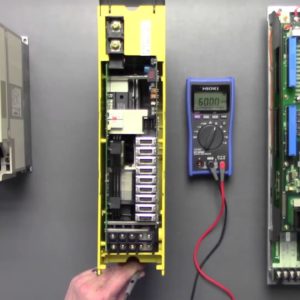Hi I'm Rob with Precision Zone and I'm
going to be going over a few troubleshooting steps or static checking, if you will, on some of these AC servo drives. Now part of troubleshooting is
performing a static check on your drive and the first thing that we're going to
do is make sure we turn off the machine and let the drive sit for some time so
the DC bus discharges. Now you could leave your drive installed in the
machine if you would like. You don't really have to pull it out but you do
have to remove the inputs and the outputs before you'd perform a static check or
you're going to get a whacky reading.
One of the first checks that you can
perform is just a visual check. Now on this little driver right here the first
thing that we did notice when we received it are these ground screws are
not green anymore they're black. Well that was a pretty good indication that
something went very wrong inside of this drive and that's what we verified when
we static checked it. So a visual inspection of all the components on the
boards, all the capacitors, all the resistors. all the LEDs, making sure that
nothing looks burnt or broken. Smell is also a great indication when this thing
first came in. It did not smell very well. So after as a visual check has been
performed and the drive has been sitting for some time, you're going to want to
access the DC bus and check to see if it's discharged.
Now on some
manufacturers they make the DC bus very accessible and on some manufacturers
they don't make it very accessible at all. And also as time has gone on, drives
and inverters have gotten more sophisticated and checking them has
become the same but it's become a lot easier because of the way that drives
are now designed. As you can see here on this Mitsubishi Drive and this Okuma
drive the only way that you can access the DC bus is going directly to the DC
bus capacitor. And we don't really recommend getting in
there unless you really know what you're doing with a set of probes. On these two
drives right here, this Yaskawa and this Fanuc, they actually make the DC bus
extremely easy to get at especially on this newer Fanuc that has the inverter
converter design. On this you Yaskawa, they put the DC bus right here on the
terminals also making it very convenient.
So before we go disconnecting the wires
going to our DC bus we're going to go ahead and check to make sure that the DC
bus has been discharged. So we're going to go ahead and take a quality meter
just like this Hioki DT 4252 meter we're going to set it
to the DC setting and then we're going to take the positive side of the probe
and place it on the positive side of the DC plus and the negative probe on the
negative DC bus and take a reading and we're not showing any voltage which is
great.

Now I wouldn't proceed any farther I would just go ahead and give it some
more time before you proceed. Now it's safe to go ahead and disconnect the DC
bus and it's safe to disconnect the UVW or the RST or the L1 L2 L3. Now once you've gone ahead and disconnected them, you're going to want to make sure that all of
the terminals are screwed down tight, otherwise, it may give you some goofy
readings. So the first test that we're going to perform is a phase to ground
test and we'll go ahead and place the multimeter and the resistance function.
We're going to take the negative side of our probe and find a good ground and
then we're going to take the positive side of our probe and go between R, S,
and T and U, V, and W and make sure that there's no resistance. And we'll go ahead and check this Yaskawa at the same time. Well that's great none of the inputs or
outputs are shorted to ground so we'll go ahead and move into our next test
we're going to go ahead and turn the digital multimeter to the diode setting,
and then we're going to be performing a check on the inputs using the negative
probe and placing it on the positive side of the DC bus and going between R,
S, and T and U, V, and W.
So negative probe positive side of the DC bus,
0.397, 0.397, 0.397, 0.375, 0.37, and 0.375. Well, that's great they all check good on this one, let's check out the other one. 0.5, 0.5, 0.5, same would go
for the rest of them. Now what we're going to do is switch our probes and
take the positive lead and place it on the negative side of the DC bus and then
do the check with the negative lead on all the inputs and outputs. Well that's great that these two are
checking fine now ideally you would like the reading between anywhere between
0.3 – 0.7 that's where the majority of the servo drives are
going to be now they can be outside of that but that just kind of depends on
your specific drive. And one of the most important things is that they're
balanced across all three phases now between R, S, and T and U, V, and W between
those two there could be a little bit different and that would be okay but
between R, S, and T, they really need to be balanced as the same thing between U, V, and W.
If you've gone ahead and performed these tests and everything checks good
and you're still having alarm problems, go ahead and reach us at www.precisionzone.com where we can provide you with some more help. I hope this video is helpful
and thanks for watching..

